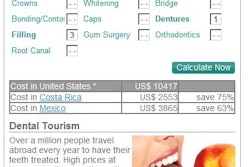U.S. dental patients are flocking to clinics just across the border with Mexico, according to a report by the Medical Tourism Association.
Between 80% and 90% of the patients at dental clinics in Mexican border towns are from the United States, the report said.
Among the popular destinations within an hour's drive of the border are Los Algodones, Nuevo Progreso, Rio Grande Valley, Matamoros, and Nogales, where clinics serve needs that can be met in one day, according to the report.
Tourism companies are beginning to specialize in taking U.S. patients to such clinics. For example, the report, Dayo Dental focuses solely on dentistry. The company charters vans every week from Phoenix, AZ, to Los Algodones, Baja California, "a town with 200 to 300 dentists and a population of only 4,021," it said. The first transport and the initial dental consultation are free to the patient. Follow-up transportation is $45 per person, but typically the patient's entire dental trip is completed within one day, said the report.
The report gave these reasons for the lower cost of dentistry in Mexico:
- The average Mexican staff member earns $3 to $5 per hour, less than a third of the cost of assistants and hygienists in the U.S., and laboratory costs are also lower.
- Monthly rent for an office in a high-traffic location ranges from $1,000 to $1,500, less than a third of what U.S. dentists pay.
- Mexicans obtain their degrees in a five-year program that starts right after high school education and costs $20,000 to $40,000 total. American dental students, meanwhile, pay at least $25,000 a year.
- Mexican dentists themselves earn less money -- about $30,000 to $50,000 a year compared to about $200,000 a year for U.S. dentists.
- A large supply of Mexican dentists has led to stiff competition for patients.
- Mexico's economy is weaker overall; the average Mexican earns $6,230 a year.
The report predicts that medical tourism will continue to grow as more people become aware of the possibility and insurance companies embrace it.



















